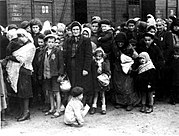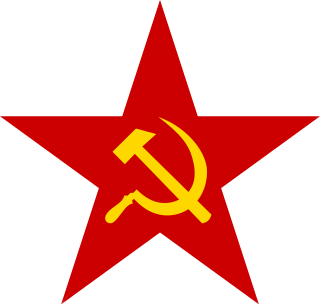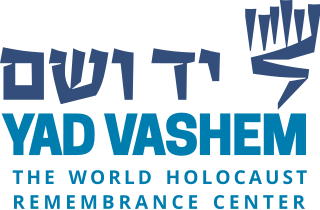
The Final Solution or the Final Solution to the Jewish Question was a Nazi plan for the genocide of Jews during World War II. The "Final Solution of the Jewish Question" was the official code name for the murder of all Jews within reach, which was not restricted to the European continent. This policy of deliberate and systematic genocide starting across German-occupied Europe was formulated in procedural and geopolitical terms by Nazi leadership in January 1942 at the Wannsee Conference held near Berlin, and culminated in the Holocaust, which saw the killing of 90% of Polish Jews, and two thirds of the Jewish population of Europe.

Babi Yar is a ravine in the Ukrainian capital Kiev and a site of massacres carried out by German forces and local Ukrainian collaborators during their campaign against the Soviet Union in World War II. The first, and best documented, of the massacres took place on 29–30 September 1941, killing approximately 33,771 Jews. The decision to kill all the Jews in Kiev was made by the military governor, Major-General Kurt Eberhard, the Police Commander for Army Group South, SS-Obergruppenführer Friedrich Jeckeln, and the Einsatzgruppe C Commander Otto Rasch. Sonderkommando 4a soldiers, along with the aid of the SD and SS Police Battalions backed by the Ukrainian Auxiliary Police carried out the orders.

The Auschwitz Album is a unique photographic record of the Holocaust during the Second World War. Along with the Sonderkommando photographs, it is the only known surviving pictorial evidence of the extermination process inside Auschwitz II-Birkenau, the German extermination camp in occupied Poland.
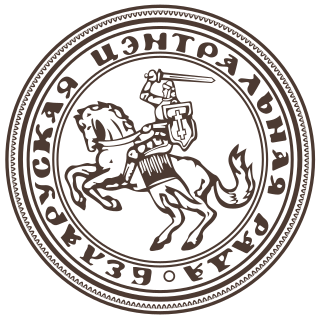
The Belarusian Central Council or the Belarusian Central Rada was a Belarusian representative body with limited governmental functions during World War II in the German occupied Belarusian SSR. It was established by Nazi Germany within Reichskommissariat Ostland in 1943–44, following a requests by the collaborationist Belarusian politicians hoping to create an independent Belarusian state with support of Nazi Germany.
Byelorussia, known today as Belarus was a republic of the Soviet Union when World War II began. The borders of Byelorussia were greatly expanded in the invasion of Poland of 1939 and finalized after World War II. Following the German military disasters at Stalingrad and Kursk, a collaborationist Byelorussian self-government (BCR) was formed by the Germans in order to drum up local support for their anti-Soviet operations. The Byelorussian BCR in turn formed the twenty-thousand strong Belarusian Home Defence (BKA), active from 23 February 1944 to 28 April 1945. Assistance was offered by the local administrative governments from the Soviet era, and prewar public organizations including the former Soviet Belarusian Youth. The country was soon overrun by the Red Army. Devastated by the war, Belarus lost significant populations and economic resources. Many battles occurred in Belarusian territory or neighboring lands. Belarusian people also participated in regional conflicts.

The history of the Jews during World War II is almost synonymous with the Jewish persecution and murder of unprecedented scale in modern times in political Europe inclusive of European North Africa. The massive scale of the Holocaust which happened during World War II heavily affected the Jewish nation and world public opinion, which only understood the dimensions of the Final Solution after the war. The genocide, known as HaShoah in Hebrew, aimed at the elimination of the Jewish people on the European continent. It was a broadly organized operation led by Nazi Germany, in which approximately six million Jews were murdered methodically and with horrifying cruelty. During the Holocaust in occupied Poland, more than one million Jews were murdered in gas chambers of the Auschwitz concentration camp alone. The murder of the Jews of Europe affected Jewish communities in Albania, Austria, Belarus, Belgium, Bosnia & Herzegovina, Channel Islands, Croatia, Czech Republic, Estonia, France, Germany, Greece, Hungary, Italy, Latvia, Libya, Lithuania, Luxembourg, Macedonia, Moldova, The Netherlands, Norway, Poland, Romania, Russia, Serbia, Slovakia, and Ukraine.

The Holocaust in German-occupied Poland was marked by the construction of death camps by Nazi Germany in Poland. The Third Reich's World War II genocide, known as the Holocaust, took the lives of three million Polish Jews, half of all Jews killed during the Holocaust. Scholars disagree on whether to also classify up to three million ethnic-Polish victims of German genocide as Holocaust victims. The extermination camps played a central role in Germany's systematic murder of over 90% of Poland's Jewish population.

Holocaust trains were railway transports run by the Deutsche Reichsbahn national railway system under the strict supervision of the German Nazis and their allies, for the purpose of forcible deportation of the Jews, as well as other victims of the Holocaust, to the German Nazi concentration, forced labour, and extermination camps.
The anti-Jewish violence in Central and Eastern Europe following the retreat of Nazi German occupational forces and the arrival of the Soviet Red Army – during the latter stages of World War II – was linked in part to postwar anarchy and economic chaos exacerbated by the Stalinist policies imposed across the territories of expanded Soviet republics and new satellite countries. The anti-semitic attacks have become frequent in Soviet towns ravaged by war; at the marketplaces, in depleted stores, in schools, and even at state enterprises. Protest letters were sent to Moscow from numerous Russian, Ukrainian and Belarusian towns by the Jewish Anti-Fascist Committee involved in documenting the Holocaust.
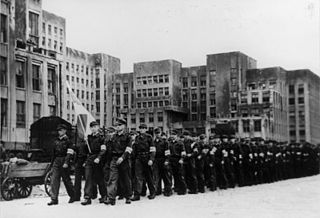
The Belarusian Home Defence, or the Byelorussian Home Guard was a name of the collaborationist volunteer battalions formed by the Belarusian Central Council (1943-1944), a pro-Nazi Belarusian self-government within Reichskommissariat Ostland during World War II.

The Holocaust in Belarus in general terms refers to the Nazi crimes committed during World War II on the territory of Belarus against Jews. The borders of Belarus however, changed dramatically following the Soviet invasion of Poland in 1939, which has been the source of confusion especially in the Soviet era as far as the scope of the Holocaust in Belarus is concerned.

Krupki is a small city in Krupki Raion, near Mogilev, Belarus.

The Grodno Ghetto was a World War II ghetto established in November 1941 by Nazi Germany in the city of Grodno for the purpose of persecution and exploitation of Jews in Western Belarus.
Nikolay Yakovlevich Kiselyov, also commonly transliterated from the Russian language as Nikolai Kiselev, was a Soviet Red Army soldier, prisoner of war, and partisan leader during World War II.

Bronna Góra is the name of a secluded area in present-day Belarus where mass killings of Polish Jews were carried out by Nazi Germany during World War II. The location was part of the eastern half of occupied Poland, which had been invaded by the Soviet Union in 1939 in agreement with Germany, and two years later captured by the Wehrmacht in Operation Barbarossa. It is estimated that from May 1942 until November of that year, during the most deadly phase of the Holocaust in Poland, some 50,000 Jews were murdered at Bronna Góra forest in death pits. The victims were transported there in Holocaust trains from the wartime ghettos, including from the Brześć Ghetto, the Pińsk Ghetto, and from the ghettos in Bereza, Janów Poleski, Kobryń (Kobryn), Horodec (pl), Antopol (Antopal), as well as other locations along the western border of the newly-formed districts of Reichskommissariat Ostland.
Daniel Romanovsky is an Israeli historian and researcher who has contributed to the study of the Holocaust in the Soviet Union under German occupation in World War II. He graduated from the Leningrad State University. Romanovsky was a Soviet refusenik politically active since the 1970s. Private seminars on the history of the Jews were held in his Leningrad apartment in the 1980s. Research on the topic was difficult in the Soviet Union because of government restrictions. In the 1970s and 1980s Romanovsky interviewed over 100 witnesses to the Holocaust, including Jews, Russians, and Belarusians, recording and cataloguing their accounts of the Final Solution.
The Holocaust in Chachersk was the ghettoization and genocide of the Jews and Romani people mainly in the Belarusian shtetl of Chachersk, as well as in the greater Chachersk District located inside the Gomel Oblast during the Holocaust. Invading Soviet-controlled Belarus as a part of Operation Barbarossa, Nazi Germany subjected Chachersk and neighboring shtetls to systematic extermination. Entire Jewish and Romani populations in the region were rounded up in Nazi-organized ghettos and later executed, in one of the earliest phases of the Final Solution.







